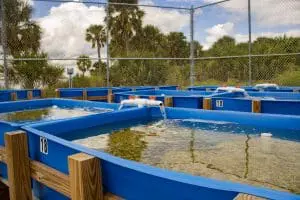

Restore Our Shores team members get to work planting.
Our first seagrass nursery is now fully functional and growing seagrass! This nursery, which was built in partnership with the Hubbs-SeaWorld Research Institute (HSWRI), is in Melbourne Beach.
In addition, our Zoo’s SECOND seagrass nursery is nearly fully functional – this one is located in Rockledge! This nursery will give us the opportunity to learn how to use a different type of growing system that can be used at properties not directly adjacent to the lagoon.
We hope the plants grown at both nurseries will be used in Restore Our Shores lagoon restoration projects next year, and we plan to offer any extra seagrass to our partners.
The Zoo is one of five organizations selected by the Indian River Lagoon NEP (IRLNEP) to increase seagrass nursery capacity on the lagoon with the goal of accelerating recovery over the course of five years. The other organizations include Marine Discovery Center, Harbor Branch Oceanographic Institute, Florida Oceanographic Society, and Sea & Shoreline. Our ROS team meets regularly with the other partners and IRLNEP to collaborate and learn from one another. The funding for these two nurseries was entrusted to IRLNEP by the EPA thanks to the Bipartisan Infrastructure Law.
Each of our nurseries will focus on a different way to grow seagrass.

Our nursery has a system of four tanks that pull water from the nearby lagoon.
The Melbourne Beach nursery has six 880-gallon raceways, or systems of four tanks, and our staff will pull water from the nearby lagoon for the tanks. Our Rockledge nursery system is essentially a concrete slab with concrete blocks and a liner forming a pool. While this system is less expensive in the initial set-up, there’s no nearby source of water from the lagoon, so our ROS team will be making their own water for the seagrass. Our goal is to see which system works best for our needs in terms of efficiency of seagrass production.
Seagrass is the basis of a healthy lagoon ecosystem, so long-term, successful re–establishment of this critical resource will benefit all species in the lagoon – even manatees – and be used in ROS restoration projects throughout the lagoon.

An example of the seagrass species we will be planting.
Initially, we will be working with Halodule wrightii, or shoal grass, but we plan to expand to other seagrass species.
While the seagrass nurseries will be overseen by staff, regular trained volunteers will assist in day-to-day care of seagrass. If you’re interested in becoming a volunteer, please email restoreourshores@brevardzoo.org for more information.
We appreciate the support of our community as we continue to add to our lagoon restoration work. To those of you who have been on this journey with us – thank you!
Brevard Zoo is an independent, not-for-profit organization that receives no recurring government funding for our operating costs. Your generous support enables us to continue to serve our community and continue our vital animal wellness, education and conservation programs.
